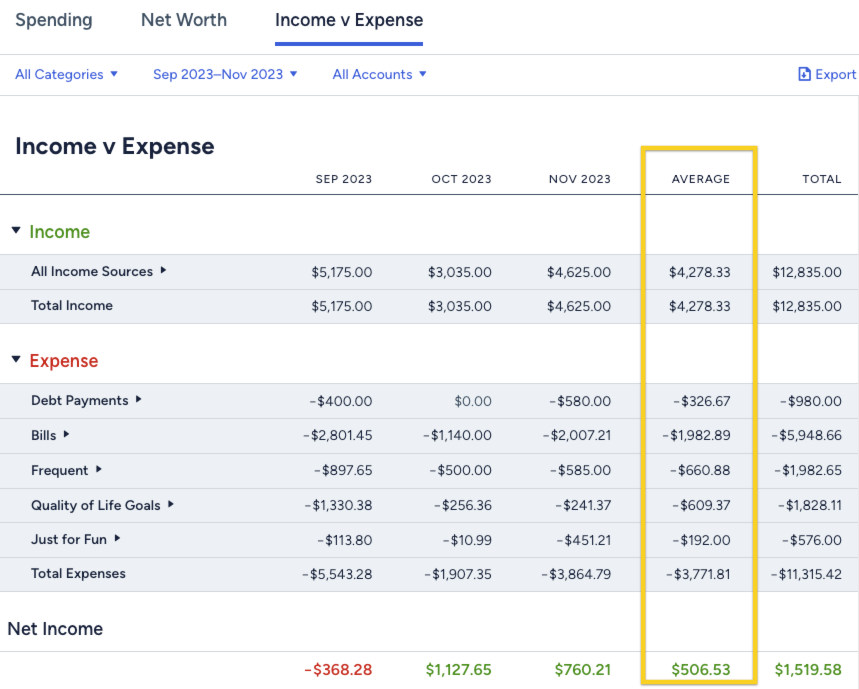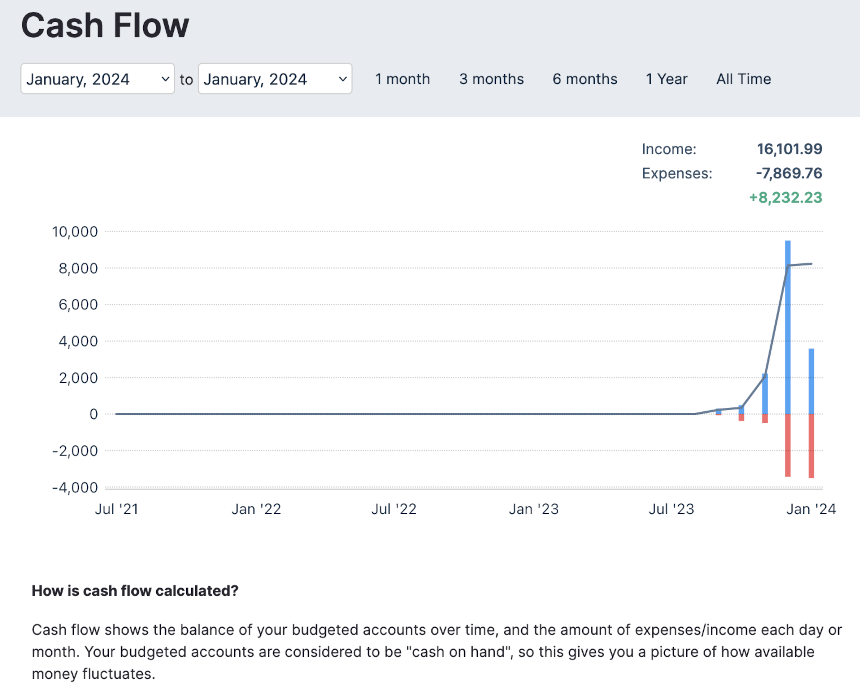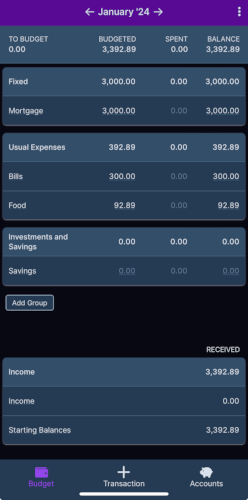Posted on:
You Need a Budget #
I opened my email on Monday morning and I had received a new message from YNAB titled Heads Up! Your YNAB Subscription Is Up For Renewal! This is something I knew was coming (I've even budgeted for it) but, it's not something I'm very excited about for a couple of reasons. The first of which is that I'm not a fan of software subscriptions for something that should be a one time purchase license. I don't want to rent my software that's already feature complete, stable, and where usage of the software isn't costing the developer overhead for server rentals, a bunch of storage, etc. While new YNAB is a hosted web service, it clearly doesn't have to be. Up to the deprecation of YNAB4, it was always a desktop application you paid once for and owned forever. No web servers for the company to host your data on, no monthly recurring costs to them per user. To be clear, I don't have an issue paying for software, especially good software that a lot of thought and hard work has gone into. Developers need to eat too and all of that. I will happily upgrade once a year or so when a new version comes out if the improvements justify the cost. However, if the version I've already paid for still suits all of my needs, I want the choice not to upgrade until I feel the need to. I don't see anything wrong with that.
Reason number two is that I really want to own my own data. To nYNAB's credit, you can absolutely export your data in an open format. YNAB's Privacy Policy also states that they won't sell your data. I still feel better having my data in my hands, on my drives. The privacy policy won't change. The company won't suddenly go under and shutdown the web app. They can't suspend my account for some reason. I won't lose access to my data if I stop paying the annual fee. Speaking of which, back to reason one, the annual price has gone up (like every other subscription under the sun) from $83.99/yr to $98.99/yr. This isn't a HUGE change but, it is yet another point of contention. If I own the software and a new version is released that costs a bit more than the last, I can decide whether it's worth the price and won't lose access to my data because I didn't shell out this year.
Actual Budget #
A few months ago an article from It's FOSS News showed up on my RSS reader about Actual Budget. Actual Budget was a hosted budget platform using the same envelope style budgeting system as YNAB. The developer recently decided to open-source the project and released a self-hostable version of the server. There's even a super easy to deploy docker container. I thought this looked really interesting and deployed it on my home server to check out. With the help of their pretty awesome documentation, I was able to export my data from nYNAB and import it into Actual. I got it all setup and started tinkering but, I ran into some snags and it didn't catch on at the time. I had one real problem, the rest are differences in features and functionality.
The problem was a large difference in what funds YNAB showed I had in Ready to Assign vs. what Actual showed in it's To Budget section. I could not for the life of me figure out why these numbers didn't line up. The documentation does say:
nYNAB calculates its Ready to Assign value differently than Actual's To Budget value. There is no need to worry, we can make them match exactly with a simple change. This is purely a visual change and doesn't affect the budget itself.
You will likely see money leftover in each of the imported months in your To Budget. This extra comes from nYNAB including funds budgeted in future months when calculating its Ready to Assign value. Actual does not include those funds by default, but offers a way to manually reserve funds for use if future months. This is affectively the same thing nYNAB does, but in a manual form.
However, despite now understanding that difference, even after following the steps to "hold" money for next month, the numbers still didn't line up. All of the other numbers add up and everything looks the same on both apps apart from this one number. Where is this "extra" money coming from?! It drove me crazy, I finally gave up trying to fix it and quit using Actual.
It wasn't until getting the subscription renewal email from YNAB that I finally sat down and figured out what the issue was. After several hours of doing math trying to find the difference, I realized that if I added the totals assigned to categories and subtracted that number from the totals in my accounts, the difference is what Actual shows I still have in To Budget. The number in YNAB seems to be off, not Actual! Fast forward several more hours of math and confusion and I finally found it.
YNAB has a section for credit card payments. When you spend money on a card, it moves from the transaction's assigned category to the credit card to be reserved for the card payment. I had somehow over allocated money to multiple cards (probably several months ago) and that total was the difference between YNAB and Actual. With that major headache out of the way, I'm a lot more confident in the numbers being right and I'm ready to give it another shot.
YNAB Has Some Advantages #
Account Syncing
This was a big one for me when I originally tried Actual. YNAB uses third parties like Plaid (who's had some privacy problems) or MX to facilitate collecting information from your accounts. This has been a crutch I've leaned on going all the way back to when I started using Mint somewhere around 2010. When I'm out and spend money, I rarely remember to pull my phone out as I'm finishing a transaction and enter it into my budgeting app. If I forget to do that or an auto-paid bill posts, those transactions will get pulled in within a few days for me to categorize and track, which keeps my budget in check. There are community projects for Plaid and SimpleFIN integration to Actual, but I'm going to make an effort to go manual for now. If I can manage to make manual budgeting work, I'll both avoid paying for a service and make my budgeting more active than reactive.
Reports
The Reports in YNAB are just better, full stop. Both YNAB and Actual have reports for Net Worth, YNAB has Income vs Expense while Actual has Cash Flow, and YNAB has Spending, which is probably my most used report and there's nothing like it in Actual. I find Income vs Expense to be more useful than Actual's Cash Flow, as it shows information by category, with month by month, average, and total for the specified report range. Here's a few examples from their respective demo pages.
 YNAB's Income v Expense
YNAB's Income v Expense
 Actual Budget's Cash Flow
Actual Budget's Cash Flow
Reports aren't a make or break feature for me though. I look at them maybe once or twice a month but, they are a useful feature and nice to have. Actual's website says custom reports are coming soon. I hope someone creates reports to bring Actual more in line with YNAB and maybe even surpass it in this area.
Mobile App
YNAB has a mobile app while Actual doesn't but I don't think this is going to be a huge deal for me. The mobile site UI on Actual seems pretty good, at least for my uses. I do the majority of my budget management on my computer and use mobile mostly for info at a glance and adding transactions. On iOS you can visit a webpage in Safari and select Add to Home Screen from the Share Sheet to make it behave more like a native app. This is going to be my approach for adding transactions on the go. Time will tell how well this works out for me.

Final Thoughts #
I'm looking forward to seeing how this turns out. My subscription to YNAB expires on the 30th and I intend on letting it lapse to give Actual a real go. YNAB has been a great product that I've enjoyed using. This experiment is not about my dissatisfaction with YNAB but about bringing my things under my control. Actual is still under active development and I expect there to be some challenges. I'm optimistic though, I've already seen some big changes and experimental features get added since I first tired it just a few months ago. The open-source and self-hostable nature of this project really speak to me as well. Worst case senario, I can always reactivate my YNAB subscription and continue where I left off. I just hope I never have to.
Tagged with:
More posts:
- Next: Using a New Neovim Plugin Manager
- Previous: Cisco UC 11.5 to 14 Migration